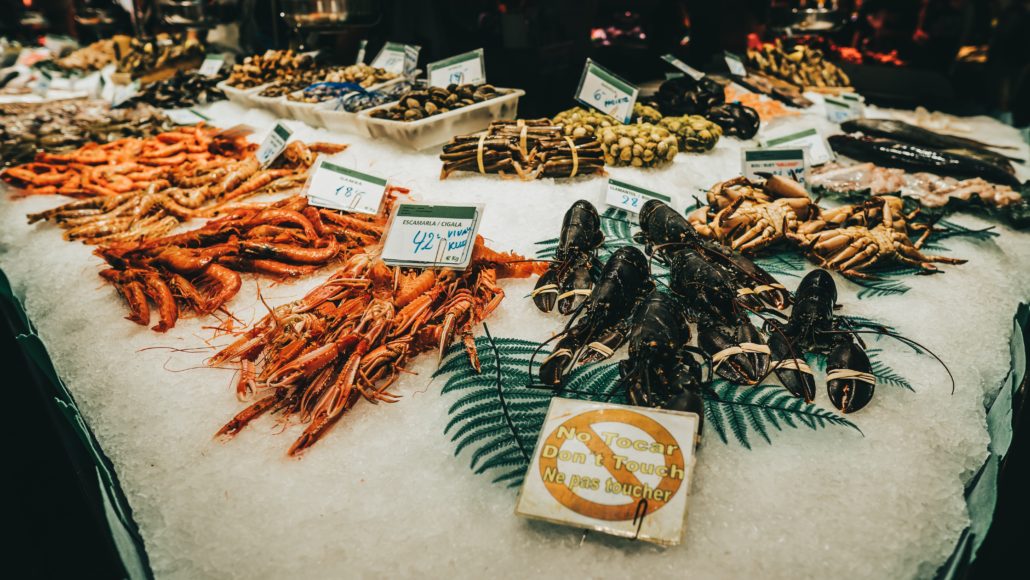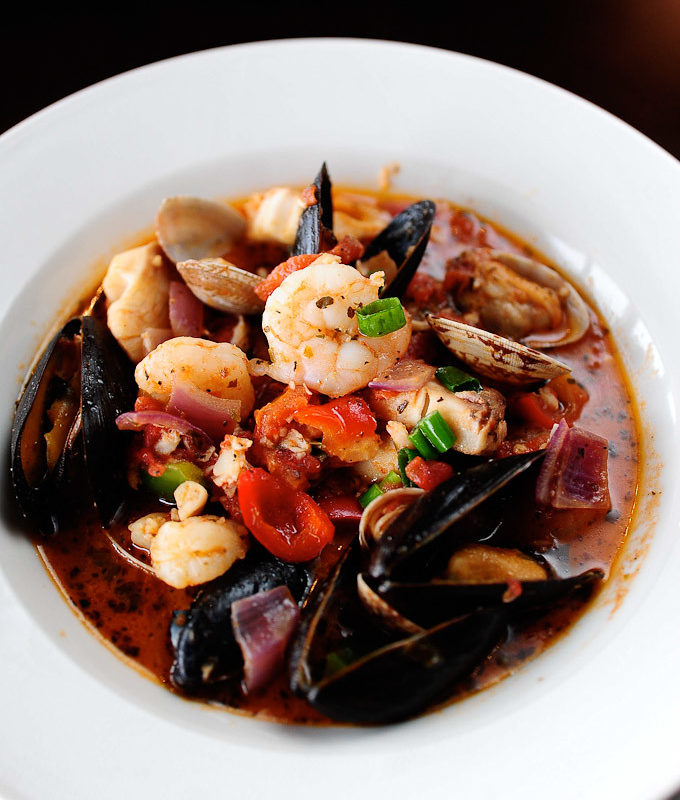
Shellfish are maybe the most sustainable and nutritious options by weight. Bivalve shellfish (a category that includes clams, oysters, and mussels) are highly sustainable to farm, having a far lower environmental footprint than animal meat, fish, wheat, soy, and rice [1]. Bivalves are much lower fat and have a higher protein content than beef. They are a rich source of omega-3 fatty acids and are some of the most concentrated dietary sources of essential minerals like zinc and selenium [1,2]. These particular minerals are also the heavy hitters when it comes to boosting your immune system as cold and flu season approaches.
Clams, which are included in this recipe, are wonderfully rich in vitamin B-12. In fact, a 3 ounce serving of clams contains, on average, 1400% of the daily B-12 recommendation [2]. Clams are also high in iron and the powerful, immune-boosting antioxidant vitamin C [2]. Although not as high in B-12, mussels are a richer source of manganese and selenium than clams. Manganese contributes to bone strength and is part of one of the body’s most important antioxidants: manganese superoxide dismutase. Manganese superoxide dismutase protects mitochondria and cellular energy production [3]. Selenium also acts as a powerful antioxidant and may be particularly effective for strengthening the immune system against viral infection [4].
Cioppino isn’t just about the seafood, however. A great cioppino also needs a silky, hearty tomato and vegetable broth that could stand alone, but does not overpower the seafood. Tomatoes are also a highly nutritious ingredient. They are a terrific source of the antioxidants lycopene (which benefits cardiovascular health), beta carotene (vitamin A), chlorogenic acid, and naringin. Naringin, in particular, has drawn recent attention for its anti-inflammatory properties and probable protective effects against a number of diseases [5,6]. Tomatoes also contain vitamins C, K, and folate, and the mineral potassium.
Is there any better smell than onions and garlic cooking? These aromatics are hardly unique to this recipe, but they pack some serious immune-boosting power. Studies have shown that garlic reduces the risk of catching a cold virus, as well as the length of illness and the severity of symptoms [7,8]. Onions contain over 25 different varieties of flavonoid antioxidants and have antibacterial properties. Quercetin, a chemical found in onion has been shown to kill harmful bacteria strains like Escherichia coli (E. coli), Pseudomonas aeruginosa, Staphylococcus aureus (S. aureus), Bacillus cereus, Helicobacter pylori (H. pylori), and Methicillin-resistant Staphylococcus aureus (MRSA) [9,10].
The takeaway is this: cioppino is sure to warm you up, impress your family, and support your immune system as we enter the cold and flu season.
Note: Before you follow this recipe exactly, or even write your grocery list, you should know a little history of cioppino. While Italian by name, its roots actually lead back to San Francisco, California. As early as the 1800s, it has been reported that fishermen would come in at the end of the day and throw whatever they had left over into a communal stew, so no one would go hungry. In the spirit of these origins, please adapt this recipe to use whatever fish, shellfish, and crustaceans look good at your fishmonger, supermarket, or the back of your freezer. This basic recipe is designed to include universally available ingredients, but can certainly be adapted. You can splurge on crab legs and scallops or save a little with frozen shrimp and chunks of whole fish. Just make sure you’re getting some of those bivalve beauties in there for a nutritional punch!

Ingredients (serves 4)
- 2 tablespoons extra virgin olive oil
- 1 medium yellow onion (finely chopped)
- 1 large leek (white and light-green parts only, sliced thin)
- 3 ribs celery (finely chopped)
- 2 bay leaves
- 1/2 teaspoon salt
- 1 red bell pepper (seeded and chopped)
- 5 cloves garlic (chopped)
- 1 teaspoon dried oregano
- 1 teaspoon dried thyme
- 1/2 teaspoon crushed red pepper
- 1 cup white wine
- 4 cups (1 carton) vegetable stock
- 28 oz (1 large can) diced tomatoes
- 12 oz (regular-sized can) tomato sauce
- 3 tablespoons tomato paste
- 2 tablespoons fish sauce (or a half can of anchovies chopped finely)
- 1 pound fresh clams in shells
- 1 pound fresh mussels in shells
- 1/2 pound shrimp (deveined)
- 1/2 pound mixed calamari rings and tentacles
- Chopped parsley (to serve)
- Crusty bread and butter to serve (can also serve over spaghetti or rice)
Instructions
In a large, heavy bottom pot (dutch oven if you have it), heat olive oil on the stove over medium high. Add onions, leeks, celery, and a pinch of sea salt. Let vegetables soften and become translucent, but not at all brown (about 7 minutes). Turn the heat down to medium, add bell peppers and cook for an additional 4 minutes before adding garlic, bay leaves, and dried spices. Stir constantly for about 3 minutes, or until spices become very fragrant.
Use white wine to deglaze your pot, scraping anything off the bottom that may have stuck. Then add vegetable broth, a large can of diced tomatoes, a small can of tomato sauce, tomato paste, and fish sauce. Bring to a boil, then lower heat to the lowest setting. Taste and add salt as needed. Allow sauce to cook uncovered for at least 20 minutes. Stir occasionally, scraping the bottom to make sure nothing is sticking or burning (***If preparing in advance, pause here until 15-20 minutes before serving).
When the table is set and you’re ready to serve, you’ll add raw seafood to the sauce in a certain order depending upon how long each takes to cook. If you add it all at once, your seafood will cook unevenly; some will get rubbery and some may turn to mush. Bring the sauce back to a simmer if it has been turned off.
- Add large chunks of raw vertebrate fish (salmon, cod, etc.) and/or crab legs and let simmer while covered for 3 minutes.
- Then raw shrimp, clams, and mussels can be added together, and cooked with the pot covered until the shells open.
- Last, add scallops and calamari and cook until opaque (2-3 more minutes).
Sprinkle with chopped parsley and serve immediately with toasty bead for dipping.
- University of Cambridge. “Scientists supercharge shellfish to tackle vitamin deficiency in humans.” ScienceDaily. ScienceDaily, 20 July 2020. www.sciencedaily.com/releases/2020/07/200720093251.htm
- Designs for Health. “Bivalves for the Brain: Nutrients in Shellfish & Crustaceans.” Designs for Health Blog. November 18, 2015. https://blog.designsforhealth.com/bivalves-for-the-brain-nutrients-in-shellfish-crustaceans
- Holley, Aaron K., et al. “Manganese superoxide dismutase: guardian of the powerhouse.” International journal of molecular sciences 12.10 (2011): 7114-7162.
- Hoffmann, Peter R., and Marla J. Berry. “The influence of selenium on immune responses.” Molecular nutrition & food research 52.11 (2008): 1273-1280.
- Story, Erica N., et al. “An update on the health effects of tomato lycopene.” Annual review of food science and technology 1 (2010): 189-210.
- Bharti, Saurabh, et al. “Preclinical evidence for the pharmacological actions of naringin: a review.” Planta medica 80.06 (2014): 437-451.
- Nantz, Meri P., et al. “Supplementation with aged garlic extract improves both NK and γδ-T cell function and reduces the severity of cold and flu symptoms: a randomized, double-blind, placebo-controlled nutrition intervention.” Clinical Nutrition 31.3 (2012): 337-344.
- Josling, Peter. “Preventing the common cold with a garlic supplement: a double-blind, placebo-controlled survey.” Advances in therapy 18.4 (2001): 189-193.
Share:
Related Posts

Goodbye Pie Chart, Hello Phase 1 Sliders
Written by Allison Smith, ND | 2025 As we usher in a new era of DUTCH testing which leaves behind the concept of the three-way

Introducing the DUTCH Dozen
Written by Kelly Ruef, ND | 2025 Hormone testing can be complex, which is why Precision Analytical developed the DUTCH Dozen, an interpretive framework that

DUTCH Report Enhancements
Written by Hilary Miller, ND | 2025 Precision Analytical have released the newest version of the DUTCH Test. This is the report’s most significant update

Gallbladder Health 101: What It Does and How to Keep It Working Well
Written by Ashley Palmer & Pooja Mahtani | 2025 The gallbladder may not get much attention compared to the gut, but it plays a central

Can You Bring Vitamins on a Plane? How To Travel with Supplements
Written by Austin Ruff | 2024 Are you traveling for a work conference, an athletic competition, or a weekend getaway? Just because you’re leaving home
